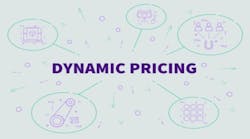For manufacturers feeling the squeeze, dynamic pricing can relieve pressure
With a new administration, many US companies are eyeing what will—or will not—change with respect to steel, aluminum and other materials import tariffs. Many are advocating for materials tariffs to stay in place, while other groups are struggling under the policy.
While the incoming administration has promised a thoughtful approach, for manufacturers feeling the margin squeeze, dynamic pricing can relieve pressure in the short term. According to Barrons, “Steel prices are on fire, rising about 67% over the past three months. Higher commodity prices mean bigger profits for producers, whose cost bases remain relatively fixed over short periods.”
Manufacturers must absorb these costs while grappling with distributor and end-customer demands to lower prices, resulting in a painful margin squeeze. Consider this: According to an epaCUBE pricing survey of thousands of distribution sellers, pricing is the No. 1 pain point. Additionally, most distribution sales teams already thought their pricing was higher than the competition, even prior to 2020. Reconciling increasing costs with demands for a reduction in pricing is a constant challenge in manufacturing.
Let’s explore how global manufacturing benchmarks reveal annual margin loss due to status-quo pricing practices, with an overview of the most common pricing pitfalls in manufacturing, and a look at how reimagining this status quo can help manufacturers address cost changes and other market triggers in a faster, more dynamic manner.
The problem: Status-quo pricing
Manufacturers rely on manual tools to set and update pricing, which results in overly-broad pricing that doesn’t satisfy the demands of complex B2B manufacturing companies. Sales teams are left to negotiate with distributors and end customers, with little more to guide them than their individual experience and intuition. As a result, manufacturers globally experience an annual margin loss of 0.51% to 7.47%.
The culprit? Misaligned market pricing, inconsistent pricing and inefficient pricing practices.
Misaligned pricing refers to transacting business at prices that fail to align rationally to customer size, order size, product value (good-better-best) and other key value dimensions. For example, a small customer may receive a better price than a large customer for the same product, all else being equal. It also includes pricing that does not quickly and accurately account for cost changes. Risk exposure to the latter is only increasing as cost changes occur more frequently and unpredictably in a global recessionary environment.
Price grooving is also a common source of margin leakage, creating inconsistent prices where prices are rounded to the nearest dollar or offered at only discrete margins, such as 30%, where perhaps a margin of 33.5% would have been sufficient to win the deal.
No one sets out to make these kinds of pricing mistakes. So why do they occur? Pricing in manufacturing is difficult due to the acceleration of external pricing triggers in modern business coupled with outmoded internal processes that can’t scale to meet the moment.
Pricing teams are constantly in a reactive position, trying to pass through increasingly volatile raw-material costs, setting a pricing strategy that sales reps will honor, dealing with channel conflict, responding to new competitors, or keeping up with the omnichannel demands of customers. Pricing decisions are often decentralized and subjective, which makes it incredibly difficult to deliver a relevant price to customers in eCommerce channels. Without the technology toolset and ability to analyze data and collaborate within a single source-of-pricing truth, manufacturers find themselves unable to adapt to new digital buying norms—leaking margin, and likely volume, all the while.
The solution: Dynamic, AI-driven pricing
To relieve this pressure, manufacturers largely have an untapped opportunity: leveraging advanced price-optimization and management tools to set more granular, scientific cost pass-through strategies and dynamically update pricing across the business as costs change. By doing so, manufacturers can enhance their pricing functions with a variety of capabilities that include:
- Allowing pricing teams to set optimized, market-aligned prices that are contextually relevant for every selling circumstance
- Addressing all price types or modes, including list, matrix, negotiated, into stock, override, customer specific, project and configured pricing
- Empowering pricing what-if scenarios to determine the predicted revenue and margin impacts of different pricing strategies and decisions
- Enabling pricing teams to intelligently respond to market conditions and cost changes in real time, better meet customers’ expectations, and deliver prices directly in CPQ, commerce or ERP systems
- Accurately measuring the impact of pricing strategies on business performance
- Scaling to support large product assortments in highly dynamic pricing environments
The net result is more market-aligned pricing that meets distributor expectations, the ability to immediately address material-cost increases, among other market triggers that necessitate a price change, and a potential margin increase of 1-3%.
By Pete Eppele is SVP at Zilliant



